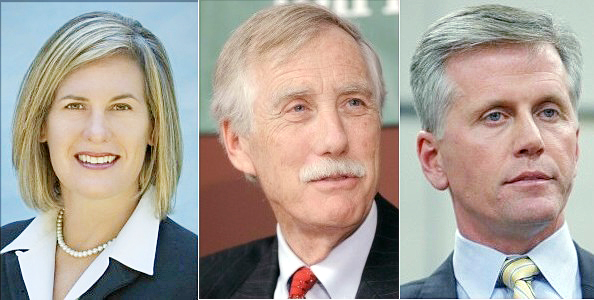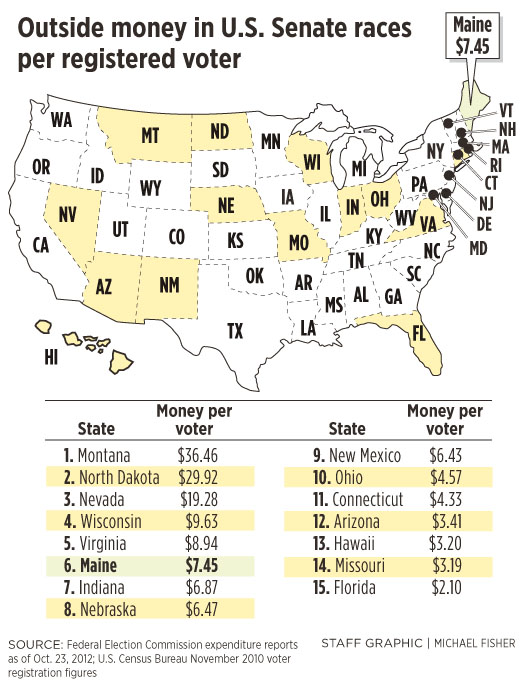WASHINGTON – Out-of-state organizations have spent as much as 70 percent more money per voter trying to influence Maine’s U.S. Senate election than the campaigns themselves.
Additionally, outside groups have paid for more than 60 percent of the nearly 10,000 Senate-related television ads that have aired on Maine’s major broadcasting networks since this summer.
Those two findings — based on separate analyses by the Portland Press Herald and an independent ad tracking group — highlight the dramatic way the political landscape has changed since federal court rulings gave rise to super PACs and unlimited corporate donations.
“Everybody assumed (outside spending) would go up a lot, but I don’t think anybody knew on what scale, and it turned out to be very substantial,” said Bob Biersack, a senior fellow at the Center for Responsive Politics, which monitors and analyzes campaign spending.
Less than two weeks before Election Day, the campaign spigots appear to have opened all the way in Maine’s race to replace retiring Sen. Olympia Snowe. Groups from outside of Maine are behind much of the spending as Republicans and Democrats fight for every seat in the closely divided Senate.
As of Tuesday, political action committees, super PACs and other outside organizations had spent roughly $5.8 million on the race involving independent Angus King, Republican Charlie Summers and Democrat Cynthia Dill. The U.S. Chamber of Commerce and the National Republican Senatorial Committee had spent more than $1.3 million to help Summers, while Americans Elect and the Democratic Senatorial Campaign Committee had spent more than $1 million each to support King or oppose Summers.
The candidates, by comparison, had spent slightly more than $3.4 million as of Oct. 17, according to the campaigns and reports to the Federal Election Commission.
Put another way, outside groups had spent $7.45 to reach each of Maine’s roughly 779,000 registered voters, compared with the $4.37 spent per voter by the campaigns. That gap has likely shrunk somewhat because of subsequent campaign spending.
While the $5.8 million total is less than the “independent expenditures” in a dozen other Senate races — with Virginia’s $32 million leading as of Tuesday — the outside spending in Maine is more impressive considering the size of the audience.
The Press Herald found that, as of midweek, Maine’s Senate race was sixth in the nation in per-voter spending by political action committees, super PACs and politically involved nonprofits.
Ohio’s Senate race had attracted nearly five times as much outside spending — $25.6 million as of Tuesday — but the per-voter spending was only $4.57.
The same was true in such Senate battleground states as Missouri ($3.19 per voter), Connecticut ($4.33) and Florida ($2.10).
The leader among Senate races, by far, was Montana, where outside groups had poured in $18 million to reach the state’s 491,000 registered voters — $36.46 per voter.
David Parker, an associate professor at Montana State University, said the airwaves in Montana’s five television markets are saturated with ads in the race between Democratic Sen. John Tester and his Republican challenger, Denny Rehberg.
Among all of those ads, Parker counted just two funded by outside groups that carried a positive message.
By Nov. 6, Montanans may have seen as much as $24 million worth of television advertising alone, Parker said. That doesn’t include spending on mailers, radio advertising and get-out-the-vote efforts, he said.
While the ad onslaught is eliciting grumbles and some talk of campaign finance reform, Parker suggested the efforts are likely working in one key respect. “If anything, it is going to drive more people to the polls,” he said.
Mainers have seen their share of political ads, and will see many more before Election Day.
The campaigns and outside groups bought airtime for nearly 10,000 television ads on major broadcasting networks from June 1 to Oct. 21. More than 5,900 of those ads aired in October, according to an ad tracking survey by the Wesleyan Media Project, run by Wesleyan University and other partners.
Outside groups were responsible for more than 6,000 of the ads aired since June 1, with the candidates’ campaigns airing another 3,600 through Oct. 21, the Wesleyan Media Project reported Wednesday.
“What is surprising is the amount of (financial) support this late in the game,” said Michael Franz, an associate professor at Bowdoin College in Brunswick who is co-director of the Wesleyan Media Project. “That indicates that something has people nervous or someone sees an opportunity.”
Many ads have targeted King, an independent who appears to have the implicit — if not openly disclosed — support of national Democrats. King aired 1,035 ads during the first three weeks of October, while organizations supporting King or opposing Summers paid for another 2,058 ads during that period.
Dill, the Democrat in the Senate race, has not aired any ads and has not been specifically endorsed by any outside groups’ advertising in recent weeks.
Crystal Canney, spokeswoman for King’s campaign, noted that King asked his two major-party opponents to disavow outside spending right after they both won their primaries in June, but Summers did not endorse the proposal.
The anti-King ads — many of them focused on his ties to the wind energy business and his record as governor — have changed the discussion in the race.
But with the exception of one wind power-related response ad, Canney insisted that outside spending has not changed King’s campaign.
King has benefited from supportive ads by the nonprofit Americans Elect, and from ads targeting Summers by the Democratic Senatorial Campaign Committee, which has not endorsed Dill and is believed to support King.
“There certainly has been a television ad war,” Canney said. “We had a plan in place, we have executed that plan in the past few weeks and we are not changing course. Things look pretty good.”
Drew Brandewie, spokesman for Summers, insisted that the outside ads have not changed his candidate’s campaign.
Nationwide, outside groups have already spent more than $700 million on the 2012 elections, including the race for the White House. That is up from roughly $260 million in 2008, according to opensecrets.org, the website operated by the Center for Responsive Politics.
The center’s Biersack said all that spending adds uncertainty to the election, takes away campaigns’ ability to control their messages and forces candidates to spend more time fundraising than listening to voters or debating the issues.
Washington Bureau Chief Kevin Miller can be contacted at 317-6256 or at:
kmiller@mainetoday.com
Twitter: @KevinMillerDC
Send questions/comments to the editors.





Comments are no longer available on this story